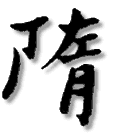


SUI581 - 618 |

|
China was reunified by Wendi, a general from the northwest by establishing the short-lived Sui dynasty in A.D. 581.
The relationship of the Sui to the succeeding T'ang Dynasty, has often been compared to that of the earlier Qin to the Han in tenure and the ruthlessness of its accomplishments. But, the similarities goes even further since both also served as the unifying foundation on which its successor could build.
The Sui dynasty's early demise is attributed to the government's tyrannical demands on the people, who bore the crushing burden of taxes and compulsory labor.
The first emperor introduced a series of economic reforms, such as reduction of the peasants' taxes, a careful census for equitable tax collection, and restoration of the equal allocation system used in the Northern Wei. Every taxable male received a grant of land, part of which was returnable when he ceased to be a taxpayer at age 60 and part of which he could pass on to his heirs. Wendi also revived the Han system of examinations, based on Confucian classics.
Wendi's premature death might have been caused by his ambitious son Yangdi, whose grandiose projects and military campaigns ultimately led to the Sui's disintegration through a combination of popular revolts, disloyalty, and assassination.
Yangdi overstrained the resources of the nation by the completion of the Grand Canal - a monumental engineering feat which linked up the Huang, Huai, and Yangtze rivers and connected north and south China - and in the undertaking of other construction projects, including the reconstruction of the Great Wall.
Weakened by costly and disastrous military campaigns against Korea in the early seventh century, the Chinese army of over a million men was defeated and forced to flee. In 618, Yangdi was assassinated in an army coup. Li Shiwen, one of the coup leaders, installed his father as emperor thus founding the T'ang Dynasty. After about a decade he took the throne himself in 626 as the emperor Taizong .

The text is based on, CHINA - a Country Study by Federal Research Division, Library of Congress, Edited by Robert L. Worden, Andrea Matles Savada and Ronald E. Dolan. Research Completed July 1987. This version and Webpage © Jan-Erik Nilsson, Gothenburg, Sweden, 2000